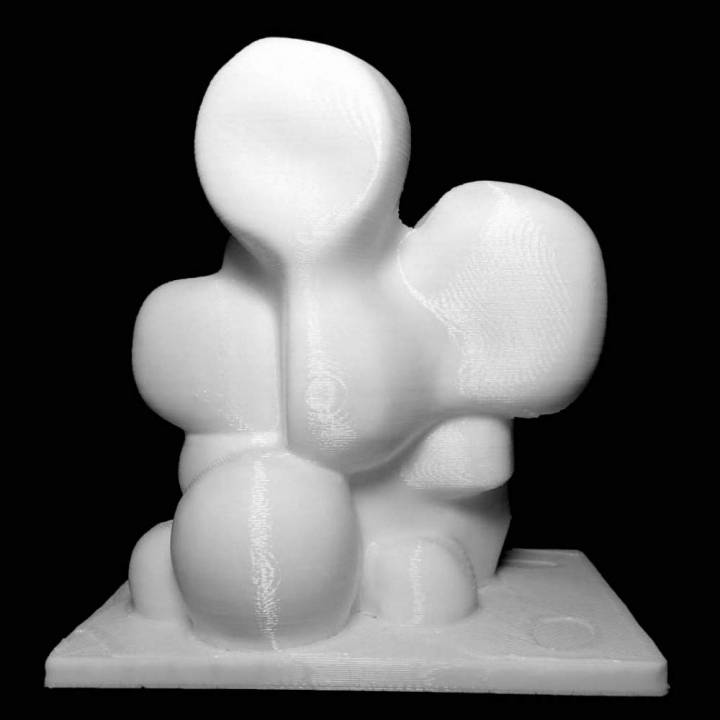
Reklama
3D tiskárny



AONN.cz
Sp┼Ö├ítelen├ę Weby
|
3D modely ARTPol Spilliaert at the Middelheim Museum

Title Pol Spilliaert Artist Aan Victor Servranck Date x Medium x Dimensions x Accession# x Credit Placed at the Middelheim Museum Victor Désiré Servranckx (Diegem , June 26, 1897 - Vilvoorde, December 11, 1965 ) was a Belgian abstract working artist, a pioneer of avant- garde art in Belgium . He is one of the few artists in Belgium that abstract art has practiced until his death . He has also made ÔÇőÔÇőseveral abstract sculptures in his early years and also worked for several years as an architect. From childhood he was busy sketching and sculpting and modeling with abstract, meaningless forms. He himself believed that this artistic trait came from mother's side. She herself liked to paint and her three brothers were painter or decorator. After the village school in Diegem he entered the Minor Seminary in Hoogstraten. There, he flamingant in protest because no Flemish word should be spoken on Wednesday. From the first year of secondary education, he went to Brussels to the Institute of the Brothers of the Christian Schools. He studied French and obtained in 1913 the diploma of surveyor. The age of sixteen, he studied in the morning at the Art Academy of Brussels until 1917. He studied among others by Adolphe Crespin., Who saw in him a gifted student. Servranckx graduated in 1917 with the Grand Prize of the Academy. When he had made a large abstract painting said his professor Constant Montald that he voooruitging with giant strides. For he himself denies he had undergone the influence of primitive art at the academy, who taught him composition and the magic in the black arts. In 1915, he, in our opinion, made the first abstract collage of the world. This work is partly a partly gouache and collage. This training at the academy was against the wishes of his father. Therefore, he afternoon to go to work as assistant draftsman in the wallpaper factory Usines Peters-Lacroix, where his father worked as a clerk. He signed there figurative motifs with stylized flowers and animal motifs in Art Deco style. He was indeed head illustrator for the period 1917-1925. In 1922 René Magritte worked with Servranckx in designing motifs for wall paper. There Servranckx himself was anti-decorative set, he saw the mural ornamental art a lie. In 1917 was formed under the aegis of the Council of Flanders, a group of Flemish artists (including Prosper De Troyer, Felix De Boeck and victor servranckx), which the Brussels association of visual artists Do Silent Continuing wished to breathe a new life. But in 1918 the movement fell apart anyway. In 1917 could Servranckx, through the intercession of his former teacher Crespin, first abstract work exhibiting in the gallery Georges Giroux in Brussels. Michel Seuphor testified this "Ce fut la première manifestation de l'art abstrait Belgium". But the audience there was no response and no single work was sold there. In 1921 he made the abstract sculpture Opus 1 (1921), a spherical image onto a rotating plinth. This harmonious image is opened for a quarter of a sphere, and shows a smaller, processed in this opening, and in addition, a spherical cavity, the same size as the small sphere. The writer Jean-Xavier Franc called this "a globe as it were born only to let the birth of a new life" Servranckx has these various designs made of bronze and plaster. In 1922 wrote Servranckx, along with Magritte, the manuscript "L'Art pur: défense de l'esthétique", which was never published. Herein they described the subject of a picture as a "logical, economically and accurately constructed object". The amazement of the audience to come through the "settlement and the choice of lines, shapes and colors." Shortly thereafter, however, already Magritte took away from abstract art. (During his time at the academy had Servranckx acquainted include René Magritte , Karel Maes and Pierre -Louis Flouquet . He later continued to maintain close contact with them. The Archives of Contemporary Arts of Belgium ( Brussels ) has a photo from June 1922 in which these artists stand together . They searched together for a renewal in art. They defended their views , inter alia, the constructivist art magazine " 7 Arts" , which she had founded .In the twenties of the last century, the young artist's evolution through and made a transition from figurative to abstract works, via the Italian futurism (influenced by Filippo Tommaso Marinetti, founder of Italian Futurism) and the French purism. He had attended lectures by Theo van Doesburg, founder and a key member of the Dutch art movement De Stijl. Servranckx was thus one of the first abstract painters and sculptors in Belgium. This transition resulted in a constructive tendency in his work and a clean, simple, abstract geometric shape with symmetrical structures. He gave it again to dull, sober, primary colors, combined with black, white and gray. Self-defined Servranckx abstract art as "truncated honoring forms depicted unrealistic, but which are true in themselves." In this abstract geometric work he wanted to extol the technical progress in industrial society (as in Opus 43: The love of the machine or Opus 47: Glorification of the machinery). He gave in that period anyway to his works a neutral title like Opus, followed by a serial number and year. He gave this as a reason that "as an artist, I have almost no right to put my name on the work that I have received and only have passed." After all, he considered himself "as a sensitive antenna that cuts images and movies, as a channel through which images are created." He began to make a painting but when the painting was finished in his mind and he was able to recognize it in its detail. Once he has discussed five hours with Picasso on the only pure conception of abstract art, but failed to persuade him. Therefore he considered Picasso's not the artist that he could have been. But Servranckx claims his experience was working with abstract art, when he learned that even abroad other painters such as Georges Braque, Piet Mondrian and Wassily Kandinsky were working on this. In December 1923 took Servranckx, with ao Felix De Boeck, Karel Maes, René Magritte, Joseph Peeters and Pierre-Louis Flouquet, participated in the group exhibition 'Les Arts belges de l'Esprit Nouveau ", organized by La Lanterne sourde" in Egmont Palace (Brussels). But none has some of these painters pure abstract painting long continued. 1924 Servranckx gave in Brussels ' Galerie Royale " his first solo exhibition. This also meant his international breakthrough. He therefore came to the attention of famous foreign artists such as André Breton , Marcel Duchamp and Fernand Léger.In 1925 he opened, along with two brothers, a men's clothing shop in Brussels. He stopped that year painting and devoted himself since 1926 more on architecture and design of interiors. When he's painting "The square rectangle" had he had, in its opinion, the far reaches of the abstract. He presented himself as more than an architect. One of his main achievements was the façade and interior of a pharmacy in Sint-Jans-Molenbeek in 1926. He often worked with the modernist architect Huib Hoste. When he moved in 1926 from Diegem to Brussels, he burned all his earlier drawings, sketches and poems - to his later regret. From that time he personally still only an abstract canvas from 1917, and a gouache and collage partly from 1915. For a long time Servranckx stood alone with this abstract art direction in Belgium. It was sometimes an ordeal for him. He did not do it for fun, but he could not do otherwise. It was a constant battle with himself. He'd much rather lived painted at the time of the Barbizon School and landscapes. He had the opportunity to make a name as to create figurative painter and career abroad. However Servranckx became a painter with the idea to be deeply unhappy. He remained in his own country which "has been a desert for him."Mid-twenties began to doubt Servranckx the pure abstraction he held until his extreme, monochrome form had Ough. He realized that he had reached a boundary, his works the viewer hardly could touch. He then began experimenting with organic, quasi-surrealist motifs that were far removed from his former geometric shapes. His glorification of industrial development was his past. He wanted to return to the organic essence of the human being and express this in his work.From 1927 his work became wilder and more visionary, such as Opus 2 of 1927. It is painted on wood and sets the domain of water. He used the structure of the wood to the waves again. In 1928 he opened his first overseas solo exhibition at the "Galerie Der Sturm" in Berlin. In 1929 he gave a new solo exhibition at the "Le Centaure", a leading art gallery in Brussels (which also issued its own art magazine "Le Centaure" (1926-1930), in which the major art movements at home and abroad were discussed and that played an important role in Belgium in the artistic life of the twenties). In 1930 he married Helene Tyrmand, a Polish-Jewish refugee. In 1938 was born their only son Paul. From the thirties were grim tone of his paintings, in accordance with the harsh socio-economic realities of those years. On top of the surrealist motifs came menacing scenes of a sometimes apocalyptic character. He painted Cosmogonies and catastrophes, which are assuming increasing violence. In 1935 he painted a picture "Astrid" for the Universal Exhibition of 1935. Queen Astrid was not an accident. But she appears in this work with a wound to the head. Along with other elements in the painting is this a hint to surrealism. In the same period, he remained active as an architect. He designed monumental buildings which curved lines had the upper hand (in contrast to his earlier linear designs with solid areas of color). In 1939 he was in Mexico a figurative portrait of the muralist Diego Rivera, husband of Frida Kahlo.After World War II was Servranckx operates include Jeune Peinture Belge (1945-1948), along with Anne Bonnet and Louis van Lint. He was stopped architecture and remained only painting and sculpture. Around 1948 he achieved a synthesis between his early abstract-geometric style and surrealism. Its colors and shapes are quieter. From the mid-fifties began to weaken his health and he painted less and less. He was admitted in 1952 to a psychiatric clinic in Grimbergen for the treatment of depression. After he had twice had a heart attack, he moved to a rural environment in the Brabant village Elewijt. In 1965, the year of his death, he married Angeline Turcksin, whom he had met in 1946 and with whom, since 1953, lived together in Jette. His works are now scattered across many private collections, but also found in major museums around the world: the Kunstmuseum aan Zee in Ostend, the Royal Museums of Fine Arts of Belgium in Brussels, the Museum of Ixelles, the Museum of Modern Art in New York, the Centre Georges Pompidou in Paris, the Museum of Modern Art Stiftung Ludwig Wien, the Lehmbruck Museum in Duisburg. (Credit; Wikipedia) n├íhodn├Ż v├Żb─Ťr model┼»
|
©Ofrii 2012
| |||